TheUMAPJournal
Publisher
COMAP, Inc.
Executive Publisher
Solomon A. Garfunkel
ILAP Editor
Chris Arney
Dept. of Math’l Sciences
U.S. Military Academy
West Point, NY 10996
david.arney@usma.edu
On Jargon Editor
Yves Nievergelt
Dept. of Mathematics
Eastern Washington Univ.
Cheney, WA 99004
ynievergelt@ewu.edu
Reviews Editor
James M. Cargal
20 Higdon Ct.
Fort Walton Beach,
FL 32547
jmcargal@gmail.com
Chief Operating Officer
Laurie W. Arag´on
Production Manager
George Ward
Copy Editor
David R. Heesen
Distribution
John Tomicek
Vol. 38, No. 2
Editor
Paul J. Campbell
Beloit College
700 College St.
Beloit, WI 53511–5595
campbell@beloit.edu
Associate Editors
Chris Arney
Ron Barnes
Joanna A. Bieri
Robert Bosch
James M. Cargal
Lisette De Pillis
Solomon A. Garfunkel
William B. Gearhart
Richard Haberman
Jessica M. Libertini
Yves Nievergelt
Michael O’Leary
Andrew Oster
Philip D. Straffin
Shaohui Wang
Krista Watts
U.S. Military Academy
U. of Houston—Downtn
University of Redlands
Oberlin College
Fort Walton Beach, FL
Harvey Mudd College
COMAP, Inc.
Calif. State U., Fullerton
Southern Methodist U.
Virginia Military Institute
Eastern Washington U.
Towson University
Eastern Washington U.
Beloit College
Adelphi University
U.S. Military Academy
�
2017
Vol. 38, No. 2
Table of Contents
Guest Editorial
Learning and Teaching Interdisciplinary Modeling
ICM Modeling Forum
Results of the 2017 Interdisciplinary Contest in Modeling
Chris Arney ...............................................................................93
Chris Arney, ICM Director, and Amanda Beecher,
ICM Deputy Director ............................................................... 105
Analysis and Optimization of Airport Security Check
Yikai Huo, Zhiyu You, and Kan Chang ...................................... 129
Judges’ Commentary: Optimizing Passenger Throughput
at Airport Security
Jessica Libertini ....................................................................... 149
Applying Smart Growth Principles in Boulder, Colorado
and Canberra, Australia
Rachel Perley, Anna Goetter, and Nina Brown ........................... 161
Judges’ Commentary: Sustainable Cities
Kristin Arney, Amanda Beecher, Carrie Eaton, and
Jack Picciuto ............................................................................ 181
Migration to Mars
Sreeram Venkat, Nikhil Milind, and Nikhil Reddy ..................... 197
Judges’ Commentary: Migration to Mars
Chris Arney ............................................................................. 221
ICM–MCM: Procedures and Tips for a Great Experience
John Tomicek ........................................................................... 233
�
Guest Editorial
93
Guest Editorial
Learning and Teaching
Interdisciplinary Modeling
Chris Arney, ICM Director
Dept. of Mathematical Sciences
U.S. Military Academy
West Point, NY 10996
david.arney@usma.edu
Introduction
Interdisciplinary modeling combines concepts, methods, techniques,
and elements of various disciplines (in the sciences, humanities, and arts)
to
• obtain solutions to problems;
• develop understanding of issues;
• provide recommendations to decision makers; and
• implement and build tools, algorithms, and systems.
To be effective for society, interdisciplinary modeling must provide the
capability for analysts to solve realistic and challenging problems. Good
education programs teach students both disciplinary and interdisciplinary
modeling and problem-solving methods, and provide opportunities for
students to practice and hone their modeling skills. The Interdisciplinary
Contest in Modeling (ICM) R� experience is one way to build experience and
refine skills.
Here we look at the nature, processes, education, and resources related
to interdisciplinary modeling and problem solving, with the hope that stu-
dents can use this information to prepare for the ICM and improve their
interdisciplinary modeling skills.1
The UMAP Journal 38 (2) (2017) 93–104. c�Copyright 2017 by COMAP, Inc. All rights reserved.
Permission to make digital or hard copies of part or all of this work for personal or classroom use
is granted without fee provided that copies are not made or distributed for profit or commercial
advantage and that copies bear this notice. Abstracting with credit is permitted, but copyrights
for components of this work owned by others than COMAP must be honored. To copy otherwise,
to republish, to post on servers, or to redistribute to lists requires prior permission from COMAP.
1The opinions in this article are the author’s alone and do not necessarily reflect the opinion of
his colleagues, USMA, the Department of the Army, or any other US government agency.
�
38.2 (2016)
94 The UMAP Journal
Interdisciplinary Problems
Real issues and modern problems can have many challenging charac-
teristics. Some of these are:
• Intransparency (lack of clarity of the situation or changing environments
and criteria)
• Multiple Goals (many stakeholders with competing criteria)
• Complexity (large numbers of items, interrelations, decision elements,
dimensions, geometries, and time scales)
• Dynamics (time considerations, constraints, and sensitivities)
• Spatial and Geometric considerations (integral or fractional dimensions)
• Political and Social Elements (human or cyber considerations)
One element to avoid or minimize in modeling is confirmation bias, which is
favoring a preconceived notion. Confirmation bias can dramatically harm
or constrain modeling and problem solving. Modelers must be aware of
and adapt their model to avoid or resist irrelevant, biased, or erroneous
information. Since data are never perfectly accurate nor completely clean,
considerable effort to reduce errors or eliminate bad data is needed. ICM
problems often require data to be considered—and sometimes obtained or
generated—by the teams. This collection, choosing, and weighing of data
is an important step in the modeling process that should not be treated
lightly by the teams.
Mathematical Modeling
Mathematical modeling is a structured process with many loops and
choices that can make it as much art as science. In performing this process,
the modeler needs to describe the phenomena in mathematical terms. The
four basic steps in the process (as described in Arney [2014, 169–170]) are:
• Step 1: Identify the Problem The problem is stated in as precise form
as possible. Sometimes, this is an easy step, other times this may be the
most difficult step of the entire process.
• Step 2: Develop a Model This is both a translation from the natural lan-
guage statement made in Step 1 to mathematical language but also the
development of relationships between the factors involved in the prob-
lem. Because real-world situations are often too complex to allow the
modeler to account for every facet of the situation, simplifying assump-
tions must be made. Data collection is often part of model construction.
Variables are defined, notation is established, and some form of mathe-
matical relationship and/or structure is established.
�
Guest Editorial
95
• Step 3: Solve the Model The model is solved so that the answer is
understood in the context of the original problem. If the model cannot
be solved, it may need to be simplified by adding more assumptions in
Step 2.
• Step 4: Verify, Interpret, and Use the Model Before using the model,
it should be tested or verified that it makes sense and works properly.
Its output should be interpreted in the context of the problem.
It is
possible that the model works, but it’s too cumbersome or too expensive
to implement. The modeler returns to earlier steps to adjust as needed.
The modelingprocess is iterativein the sense that the modelermay need
togobacktoearlierstepsandrepeattheprocessorcontinuetocyclethrough
the entire process (or part of it) several times. If the model cannot be solved
or is too cumbersome to use, the model is simplified. If the model needs
to be more powerful, or more complication or rigor needs to be added, the
process of relaxing assumptions is called refining the model. By simplifying
and refining, the modeler can adjust the realism, accuracy, precision, and
robustness of the model. By using this mathematical modeling process,
modeling students can gain confidence to approach complex and difficult
problems and even develop their own innovative approaches to solving
problems.
Interdisciplinary Modeling
Interdisciplinary modeling is a creative process that, while sometimes
based on structured processes such as mathematical modeling, usually in-
volves an innovative and complex combination of modeling and problem-
solving methods from various disciplines and schools of thought.
The traditional modeling process was based on making viable and ap-
propriate assumptions and connections to produce a framework. This
structured, Newtonian style of modeling and problem solving was often
based in mathematics, mechanics, engineering, and physical science (see
Teller [1980]).
With the advent of the computer and the availability of tremendous
amountsofdata,moderninterdisciplinarymodelingoftenreducesassump-
tions to a minimum and attempts to embrace the complexity of the real
situation. Interdisciplinary modeling combines established methodologies
with novel procedures in its processes and structures, thus allowing for
complexity and specificity in its framework. The model is then solved,
used, implemented, tested, and/or validated, to
• produce a measure,
• design an algorithm,
• solve a problem,
�
96 The UMAP Journal
38.2 (2016)
• accomplish a task,
• understand a phenomenon,
• build a system, and/or
• make a decision.
Modeling can and usually does rely on research that incorporates accu-
rate scientific information and data, relevant knowledge, and innovative
perspectives in the model. Interdisciplinary modeling can be quantitative
or qualitative, but most viable modern models are hybrid and incorporate
many different kinds of steps and processes.
The modern form of interdisciplinary modeling is called by various
names, such as network modeling, data science, operations research, analytics,
informatics, and information science.
The most emblematic inventor of these kinds of processes was math-
ematician Norbert Wiener, whose theory of cybernetics included models
with iterative control/feedback loops. After the initial stages of cybernet-
ics in the 1950s, interdisciplinary modeling was used in design and analysis
of communication systems, electronics, biological systems, and economics
(see Wiener [1961]).
This method of interdisciplinary modeling was the key to unlocking
issues in computing, artificial intelligence, neurobiology, psychology, and
sociologicalsystems. Thisnewmodelingparadigmnotonlyallowedforthe
entry of the fields of life, behavioral, and social sciences into the modeling
world, but also began to challenge the Newtonian simplicity assumption at
a conceptuallevel. Otherinterdisciplinarymodelerssoonfollowedto make
interdisciplinarymodelingahighlyvaluablemethodologyandtool. Lorenz
provided rigorous backing through chaos theory and strange attractors to
show that even a perfectly deterministic system can behave in erratic ways.
Benˆoit Mandelbrot [1977] demonstrated that a high level of complexity
exists in rudimentarygeometricobjects that make up the world as we know
it. These ideas are now conceptual elements of interdisciplinary modeling.
Measures/Metrics
Buildinggoodmeasuresforsystemproperties,data,andthesensitivities
of their effects on the achievement of goals for the problem are important,
especially if the data set is wider than it is deep and thereby affecting most
of the elements of the model. Good measures are needed in many models,
especially when the problem is quantitative. In qualitative modeling, the
measuring is often performed by comparison. Marcus Weeks [2010] dis-
cusses determination of size by a comparison methodology and makes the
size comparison relevant to humans.
�
Guest Editorial
97
A Course in Modeling
Interdisciplinary modeling courses seek to address the complex process
of translating real-world events into mathematical and scientific language,
solving or running the resulting model (iterating as necessary), and inter-
preting the results in terms of real-worldissues. Topics often include model
developmentfromdata, regression, generalcurve-fitting,anddeterministic
and stochastic model development. Easley and Kleinberg [2010] and New-
man [2010] are textbooks that are helpful in such a course. The Guidelines
for Assessment and Instruction in Mathematical Modeling Education (GAIME)
edited by Garfunkel and Montgomery [2016] is an excellent reference for
teaching foundational courses. There are many good modeling textbooks
and some are listed below.
Interdisciplinary projects based on actual problems and issues are used
to integrate the various topics of modeling for the student. Through such
a course, students should be able to:
• Frame a question using mathematics and science to begin developing a
model.
• Understand different modeling approaches and the trade-offs with se-
lecting an approach.
• Interpret the results of a model.
During a section on optimization, students learn to:
• Take a scenario and transform it into a model focused on optimization.
• Understand how to set up an optimization formulation with decisions,
an objective, and constraints.
• Understand the unique aspects of certain optimization cases, such as
linear, integer, and dynamic programming.
• Take the solution to an optimization formulation, and interpret the an-
swer.
• Understand the robustness and sensitivity of a model.
Through the study of dynamical systems modeling, students learn to:
• Take a scenario and transform it into a model focused on a dynamical
system.
• Understand how to set up a dynamical system with an independent
variable, dependent variables, and a governing relationship.
• Interpret the model without solving the differential equations.
• Understand the robustness of the model (sensitivity).
• Understand the possibility of chaotic solutions.
�
98 The UMAP Journal
38.2 (2016)
From a stochastic point of view, students learn to:
• Take a scenario and transform it into a model while incorporating uncer-
tainty.
• Understand how to set up a probabilistic model with a random variable,
sample space, and distribution.
• Understand how to set up a Markov model with a state space, a random
variable with distribution, and state transitions.
Future Trends in Modeling
Society and organizations need experts in interdisciplinary modeling
in order to make better and faster decisions. Future modelers will need
to build viable models to confront complex multidisciplinary and interdis-
ciplinary issues in our information-centric world. High-impact areas in-
clude analyzing many issues for a larger and smarter Internet, automation
of knowledge through artificial intelligence and machine learning, high-
powered cloud computing, autonomous vehicles, and smart robots. Mod-
eling in these areas is by nature interdisciplinary.
Astrikingexampleofaprojectthatrevealsthefutureofinterdisciplinary
modeling is IBM’s development of the Watson system to compete in the
information-centric game Jeopardy. Watson’s notable success in that first
endeavor, and in many applications since, illustrates the potential of inter-
disciplinary modeling. Modern science is embracing the future contribu-
tions of interdisciplinary modeling as science shifts from little science (sin-
gle investigators)and big science (large labs workingon specific projects) to
a future of team science (multidisciplinaryteams of scientists, much like the
IBM Watson team and the ICM team framework)(see West [2016]). Modern
science, through its use of interdisciplinary modeling, is building a collec-
tive power that is more creative, more original, and more effective than
any single disciplinary perspective and the simplicity-focused Newtonian
modeling of the past.
Another example of interdisciplinary modeling is found in cyberspace,
where computing and networking are important elements in the model,
but so are ethical, political, and social elements. Data science, human psy-
chology, and many other disciplines are all parts of the virtual and digital
cyber world. The complex issues in cyber modeling are two-fold:
• What is the balance between security and performance vs. privacy and
information availability?
• How do models treat the underlying competitive nature of the attacker
vs. defender dynamic?
Hackers and malicious systems are pitted against defenders of freedom,
�


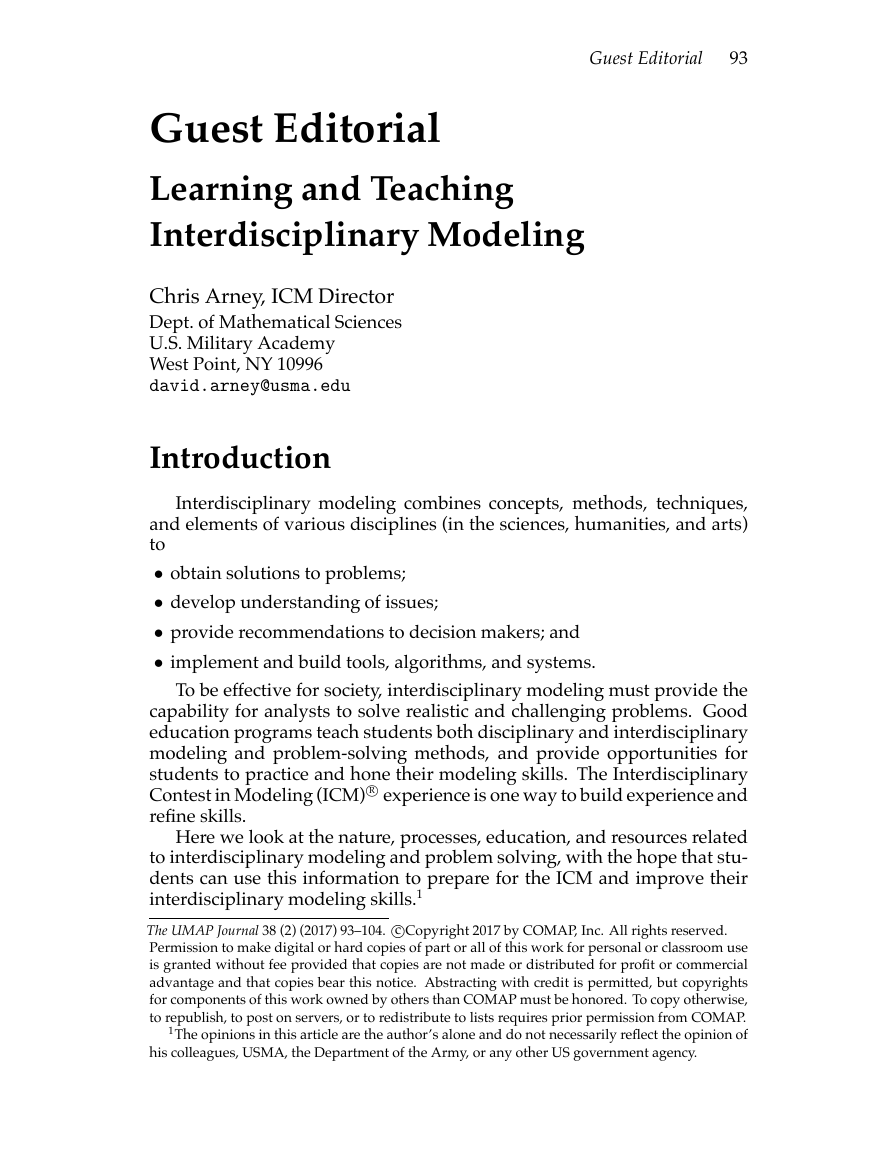
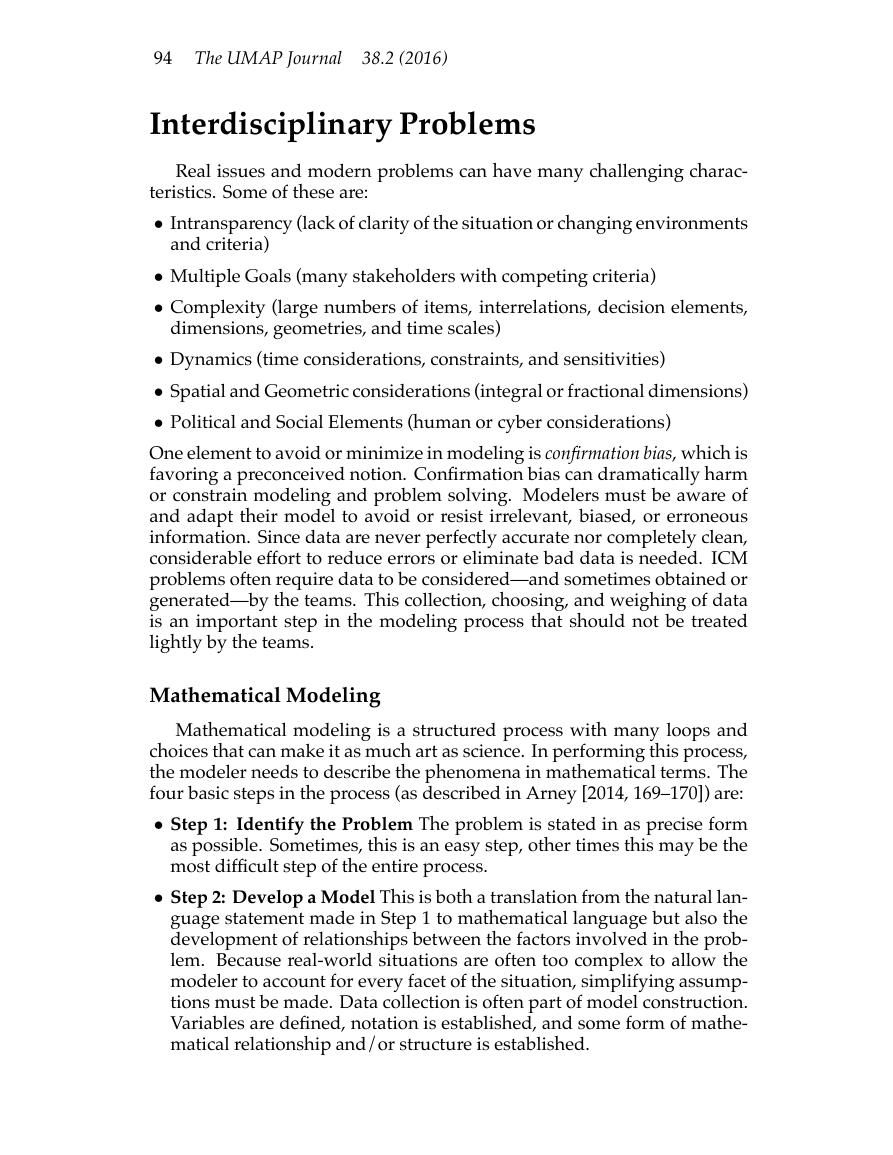
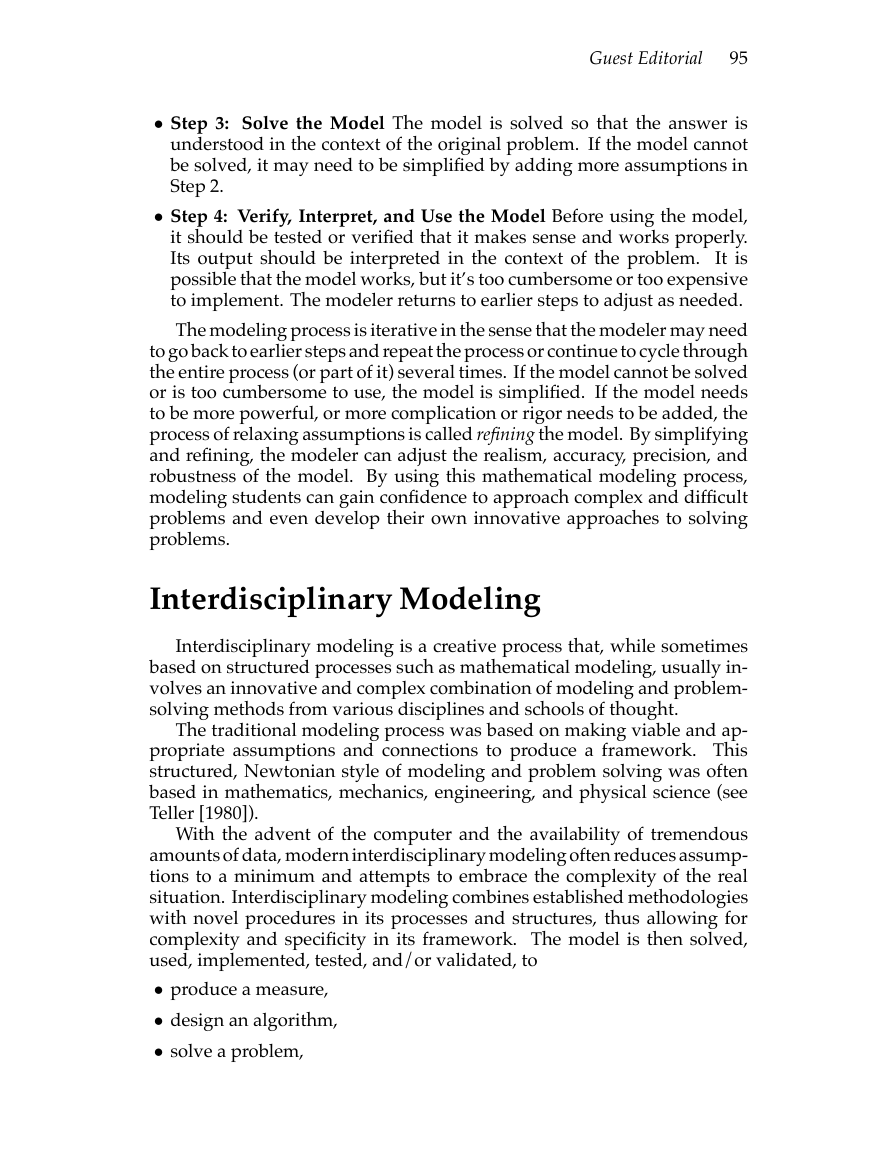
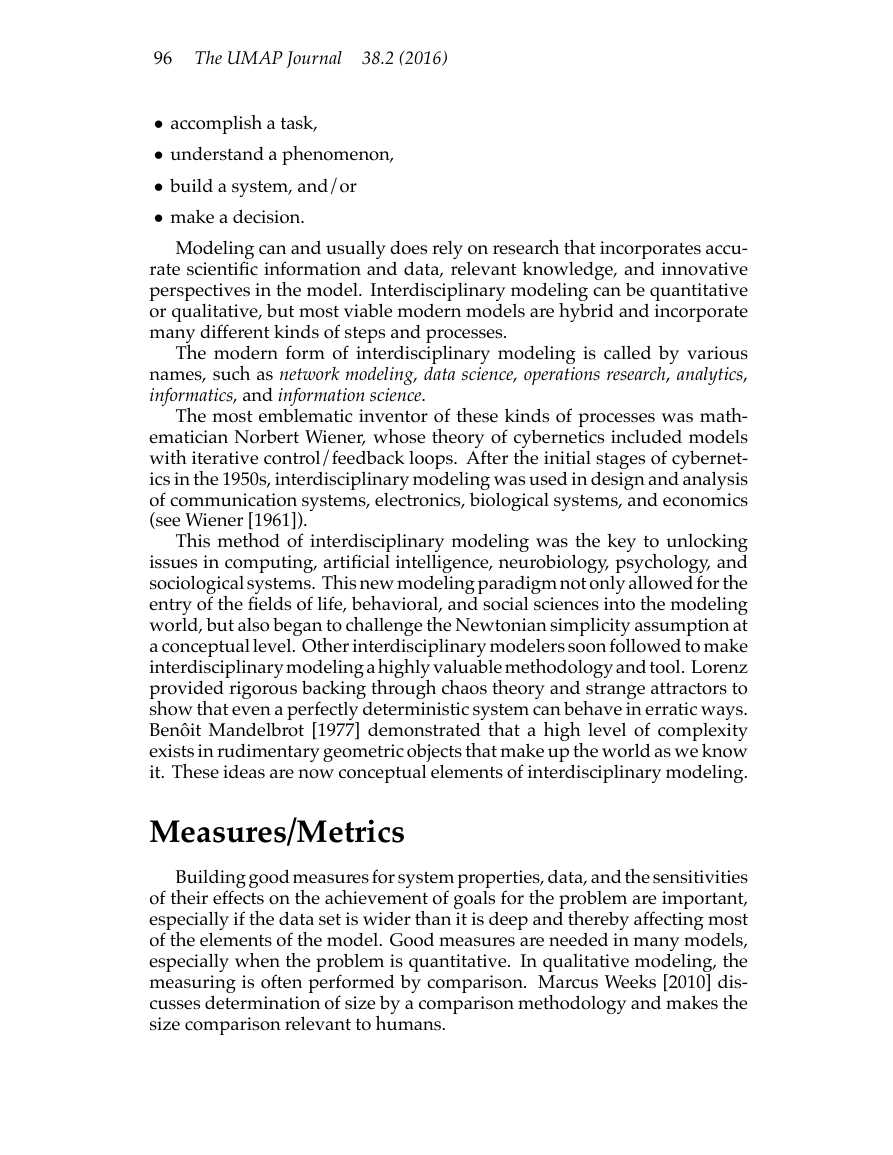
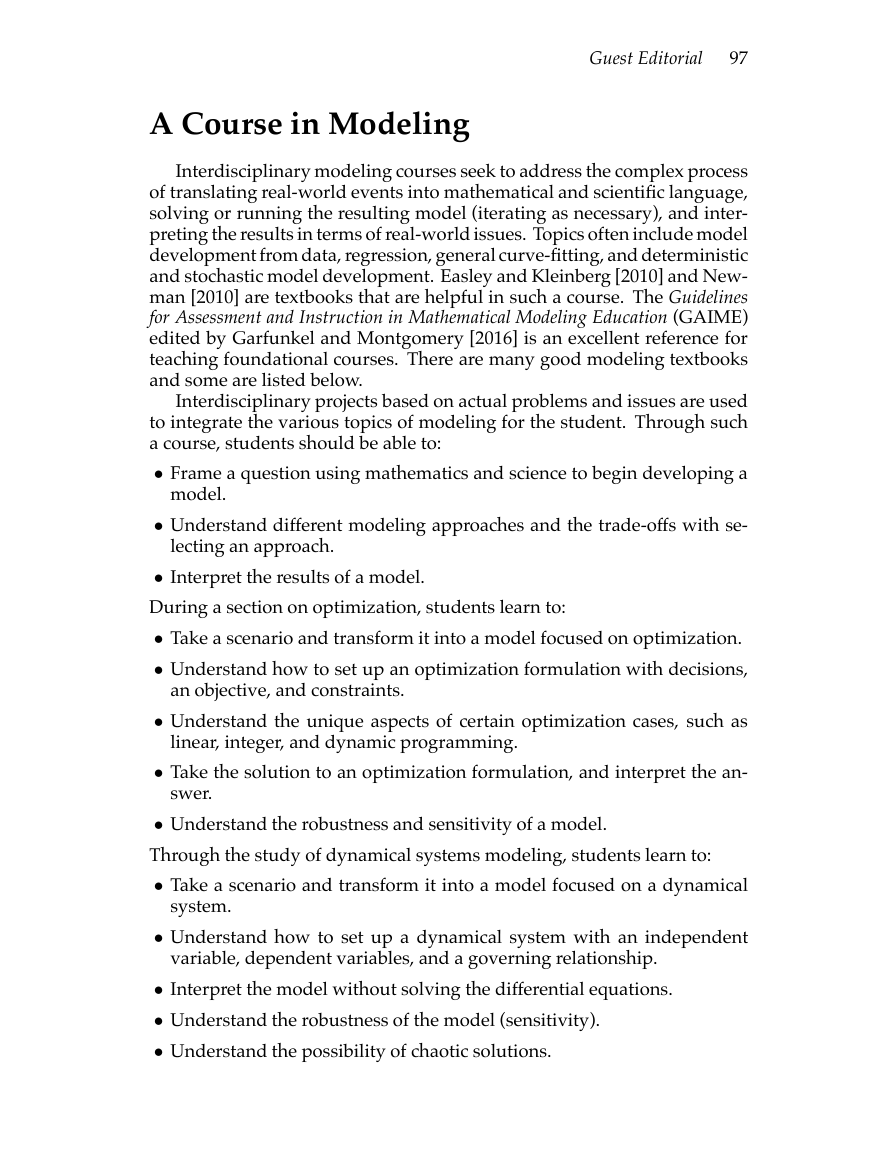
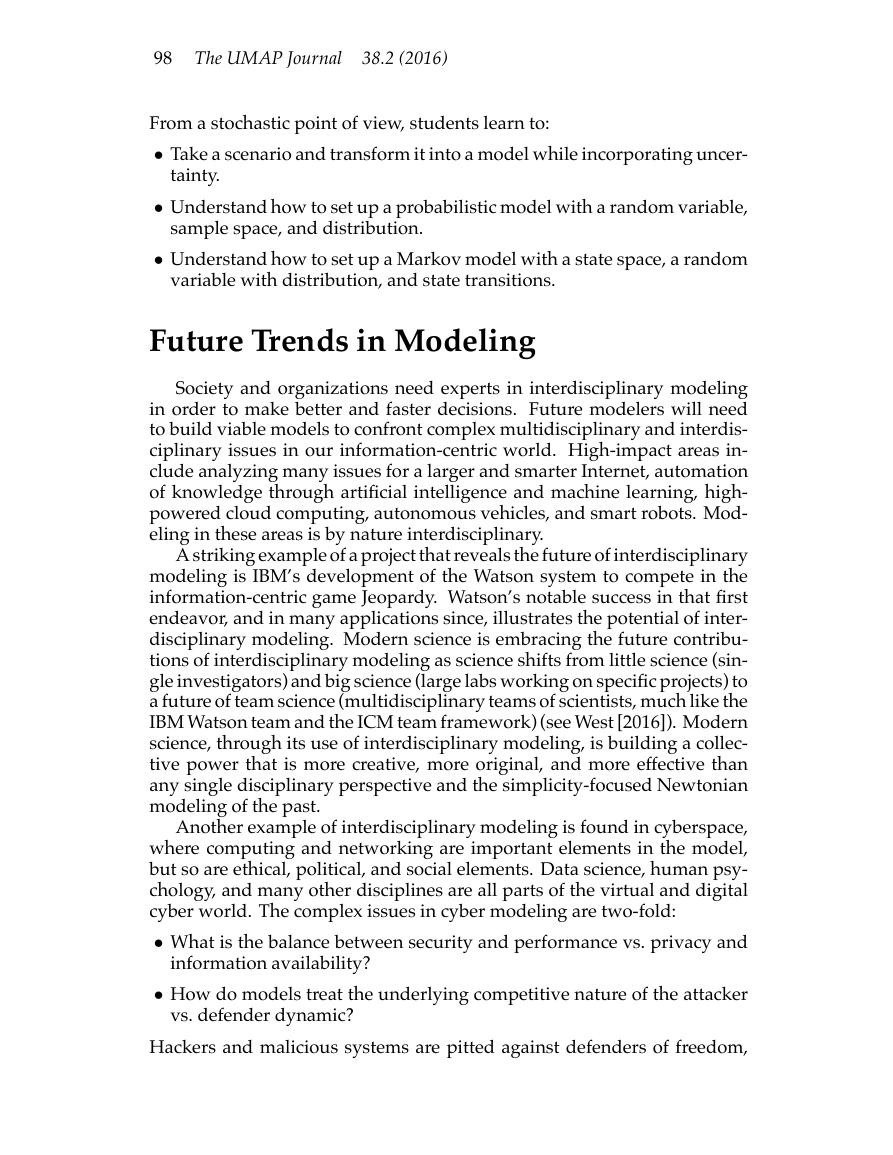








 2023年江西萍乡中考道德与法治真题及答案.doc
2023年江西萍乡中考道德与法治真题及答案.doc 2012年重庆南川中考生物真题及答案.doc
2012年重庆南川中考生物真题及答案.doc 2013年江西师范大学地理学综合及文艺理论基础考研真题.doc
2013年江西师范大学地理学综合及文艺理论基础考研真题.doc 2020年四川甘孜小升初语文真题及答案I卷.doc
2020年四川甘孜小升初语文真题及答案I卷.doc 2020年注册岩土工程师专业基础考试真题及答案.doc
2020年注册岩土工程师专业基础考试真题及答案.doc 2023-2024学年福建省厦门市九年级上学期数学月考试题及答案.doc
2023-2024学年福建省厦门市九年级上学期数学月考试题及答案.doc 2021-2022学年辽宁省沈阳市大东区九年级上学期语文期末试题及答案.doc
2021-2022学年辽宁省沈阳市大东区九年级上学期语文期末试题及答案.doc 2022-2023学年北京东城区初三第一学期物理期末试卷及答案.doc
2022-2023学年北京东城区初三第一学期物理期末试卷及答案.doc 2018上半年江西教师资格初中地理学科知识与教学能力真题及答案.doc
2018上半年江西教师资格初中地理学科知识与教学能力真题及答案.doc 2012年河北国家公务员申论考试真题及答案-省级.doc
2012年河北国家公务员申论考试真题及答案-省级.doc 2020-2021学年江苏省扬州市江都区邵樊片九年级上学期数学第一次质量检测试题及答案.doc
2020-2021学年江苏省扬州市江都区邵樊片九年级上学期数学第一次质量检测试题及答案.doc 2022下半年黑龙江教师资格证中学综合素质真题及答案.doc
2022下半年黑龙江教师资格证中学综合素质真题及答案.doc